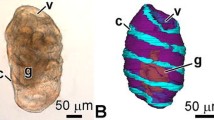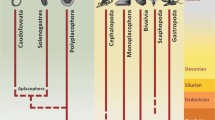Conclusion
The most striking histological features of the digestive tract ofSaccobranchus fossilis are the following:-
-
1.
Taste buds roughly resembling those of the mammals in structure are present in the lips, buccal epithelium and pharynx in great numbers and a few are present in the œsophageal region.
-
2.
In the buccal epithelium and in the anterior part of the pharynx there are giant cells, conspicuous by their one or more nuclei. These cells are dividing cells and no mention is made of them by any of the previous authors.
-
3.
The anterior region of the pharynx is separated from the posterior part, for reasons mentioned in the paper.
-
4.
No part of the free surface of the posterior region of the œsophagus, is free from mucous cells. External longitudinal muscle bundles are absent in the œsophagus.
-
5.
The pneumatic duct comes and joins the posterior part of the œsophagus, while the bile and the pancreatic ducts open into the anterior part of the intestine just near the pyloric end of the stomach.
-
6.
The stomach is divisible into cardiac and pyloric regions. The former is conspicuous by the presence of the glands while the latter is devoid of them.
-
7.
There is no pyloric valve, nevertheless, the same object is achieved by the presence of the pyloric sphincter. There is no intestinorectal valve.
Similar content being viewed by others
Abbreviations
- B. V.:
-
Blood vessel
- Bl. cp.:
-
Blood capillaries
- C. M.:
-
Circular muscle
- Ct. f.:
-
Connective tissue fibres
- Ep.:
-
Epithelium
- G. c.:
-
Goblet cell
- G. Ep.:
-
Gastric epithelium
- G. p.:
-
Gustatory pore
- Gi. c.:
-
Giant cells
- Gl. l.:
-
Gland lumen
- Gl. c.:
-
Gland cells
- Gl.:
-
Gland
- H. s. c.:
-
Hollow sphere of cells
- I. c.:
-
Investing cells
- I. ep.:
-
Intestinal epithelium
- L. m.:
-
Longitudinal muscle
- M. c.:
-
Mucous cells
- M. b.:
-
Muscle bundles
- N.:
-
Nucleus
- P. b.:
-
Pigment bodies
- S.:
-
Serosa
- S. s. c.:
-
Solid sphere of cells
- S. e. ct.:
-
Sub-epithelial connective tissue
- St. c.:
-
Stratum compactum
- T. b.:
-
Taste bud
- T. p.:
-
Top plate
- T. pr.:
-
Tunica propria
- T. s.:
-
Tooth substance
- U. c.:
-
Undifferentiated cells
- W. c.:
-
Wandering cells
- Z. g.:
-
Zymogen granules
Bibliography
Dawes, B., “The histology of the alimentary tract of the Plaice,Pleuronectes platessa,”Quar. Jour. Micr. Sci., 1929–30,73, Pt. 11, 243–74.
Greene, C. W., “Anatomy and histology of the digestive tract of the King Salmon,”Bull. U.S. Bur. Fisheries, 1912,32, 73–100.
Mary, Dora Rogick, “Studies on the comparative histology of the digestive tube of certain Teleost fishes, Minnow (Campostoma anomalum),”Jour. of Morph., 1931,52, No. 1, 7–25.
Irving, H. Blake, “Studies on the comparative histology of the digestive tube of certain Teleost fishes. The sea bass (Centropristes striatus),”Jour. of Morph. and Physiology, 1930,50, No. 1, 39–70.
Author information
Authors and Affiliations
Additional information
Communicated by Prof. C. R. Narayan Rao.
Rights and permissions
About this article
Cite this article
Vanajakshi, T.P. Histology of the digestive tract ofSaccobranchus fossilis andMacrones vittatus . Proc. Indian Acad. Sci. 7, 61–79 (1938). https://doi.org/10.1007/BF03051120
Received:
Issue Date:
DOI: https://doi.org/10.1007/BF03051120




